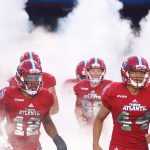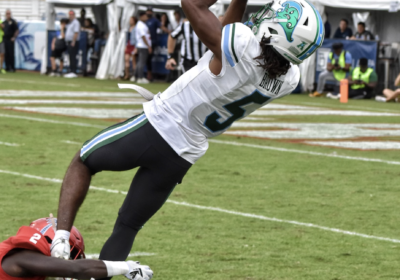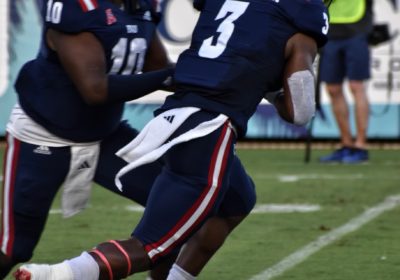[the_ad_group id=”632″]
BOCA RATON – With a week having passed since FAU football signed what most consider to be the best recruiting class in program history, now seems like a good time to consider how this class matches the needs the Owls had to fill.
Back in December, when the Owls inked the first portion of this class during the early signing period, we examined whether FAU procured what it needed from those early signees. Now, with FAU having added more than 20 additional players, we can expand on that discussion.
FAU RECRUITING NEEDS
1. Running Back: The announcements by Devin Singletary and Kerrith Whyte that they would enter the NFL draft early left the Owls without game-tested ball carriers. FAU had a potential replacement nearly in the fold all along. Former Alabama running back B. J. Emmons pledged his services to FAU back in February but never enrolled, skipping the fall semester while he completed academic work. In January Emmons enrolled at FAU. Tallahassee-Rickards running back Kelvin Dean also signed with the Owls in December. Having two potential starters already solidified in the class didn’t keep the Owls from adding more talent. On National Signing Day FAU added Hoover (Ala.) ball carrier Larry McCammon and St. Augustine-Menendez running back Tye Edwards, too. And Ocala-Vanguard’s Glover Cook, who will most likely play slot receiver, can also carry the ball.
Evaluation: The 2019 FAU recruiting class may forever be looked upon as the year of the running back. Emmons will participate in spring practices, so he’ll have an early jump on the class. The high school coaches for Dean, McCammon and Edwards speak so highly of their former players that had the Owls landed only one it would have seemed to fill the void. Lane Kiffin signed an embarrassment of riches at running back. Watching all these guys carry the ball in the fall could be the best part of fall camp. There may not be enough footballs – or goal lines.
2. Linebacker: FAU lost four seniors to graduation, leaving only three current members of the unit with game experience. In Antarrius Moultrie, Caliph Brice, Eddie Williams, Joe Lewis and Diamante Howard, FAU countered by signing five players during the early period who can play the position. Howard enrolled at FAU in January, which should provide a big boost to his ability to contribute in 2019. Having signed so many LBs early, FAU added only one additional linebacker, Miami-Edison’s Travon Thomas, who may eventually move to defensive end.
Evaluation: FAU took care of business in the early signing period, so this was already a good linebacker class heading into February. Then the Owls signed Thomas, who may be the best player in the entire class. If Thomas ultimately gets the test scores he need to qualify, the Owls should be well stocked at linebacker moving forward.
3. Wide Receiver: Heading into the early signing period FAU had only lost one player off consequence off this unit – that coming when leading pass catcher Jovon Durante declared early for the draft. But the Owls subsequently had Auburn transfer Kyle Davis return to the transfer portal and DeAndre McNeal transferred to Texas Southern, leaving FAU even more shorthanded at the position than it initially appeared. The Owls signed College of the Sequoias speedster Adrian Bryant, a move that looks like a steal. Under Kiffin, FAU hasn’t enjoyed much success with junior college receivers, but Bryant is already taking classes at FAU, giving him a chance to acclimate to the Owls’ system. Then, on Signing Day, FAU went absolutely carnivorous, gobbling up more talented receivers than anyone thought possible. The Owls added Wetumpka’s (Ala.) JD Martin, Rome’ (Ga.) Xavier Roberts, Pahokee’s Deante Nelson, Daytona Beach-Mainland’s Andrew Plummer, Notre Dame’s (Tenn.) Cam Wynn, Tampa-Plant’s Romain Mungin, Niceville’s Eyin Cole and Cook.
Evaluation: At first glance the Owls more than satisfied their needs, but there are some question marks remaining. Several of the above players still have academic work to complete before their NLI becomes official. Martin primarily played quarterback in high school and missed his senior season with a knee injury. Still, there’s plenty of talent to sustain a loss or two from this group. And even if there are some issues between now and the beginning of fall camp, this could still go down as the Owls’ best wide receiver recruiting class in history. And let’s not forget FAU is bringing Terrell Owen’s son, Terique, to Boca Raton as a walk-on.
4. Defensive End: FAU lost starter Hunter Snyder and sack leader Ernest Bagner to graduation. Returners Leighton McCarthy and Tim Bonner have yet to prove they can be consistent forces on the field. FAU didn’t sign a true defensive end during the early period, but did add Dorien Posey and Marlon Bradley on NSD, both of whom are exceptional athletes.
Evaluation: FAU already liked its talent at defensive end – perhaps more than it should. Posey and Bradley could be athletic enough to contribute early, but they will certainly benefit from some time in the weight room. Can walk-on Warren Sapp II, son of the Hall-of-Famer, repeat the success of his father? That, too, may take time. This spot could continue to be a position of need next year, too.
5. Offensive Line: FAU lost starting guard Antonio Riles and starting tackle Reggie Bain to graduation. In rising redshirt-freshmen Marquice Robinson and Doug Jones, the Owls have potential replacements at tackle. Reserve guard Nick Weber saw plenty of late-season action and could step into the starting lineup. The Owls added JUCO transfer Lavante Epson near the end of the early signing period, and he’s already on campus. FAU then signed three more offensive linemen on Signing Day, none larger than 6-foot-7, 320-pound tackle Adarius Tolliver from Autauga Academy (Ala.).
Evaluation: Getting Epson enrolled for the spring semester should pay immediate dividends in the fall. He’ll battle for a starting tackle spot. But the steal of this class may turn out to be Tolliver, who only played football for one season. He combines a basketball player’s agility with the size of an NFL lineman. If Tolliver pans out, he could anchor the Owls’ line for years to come. Federico Maranges, also relatively new to football, could surprise.
6. Quarterback: Incumbent Chris Robison and Indiana transfer Nick Tronti will battle for the starting spot next season. FAU elected to only add one quarterback to this recruiting class, signing Javion Posey out of Greenville (Ala.).
Evaluation: Posey was the guy the Owls wanted and they landed him in December, though the recruit managed to keep his decision a secret until Signing Day. Many of FAU’s offensive problems last season can be attributed to having an inexperienced QB. Robison is likely to improve, but until he shows it on the field, will FAU coaches ever feel truly comfortable with him behind center? Considering how important a quarterback is to a successful college football team, would it have made sense for FAU to sign two QBs to this class and do in ensuing classes until they have their franchise guy?







Recent Comments